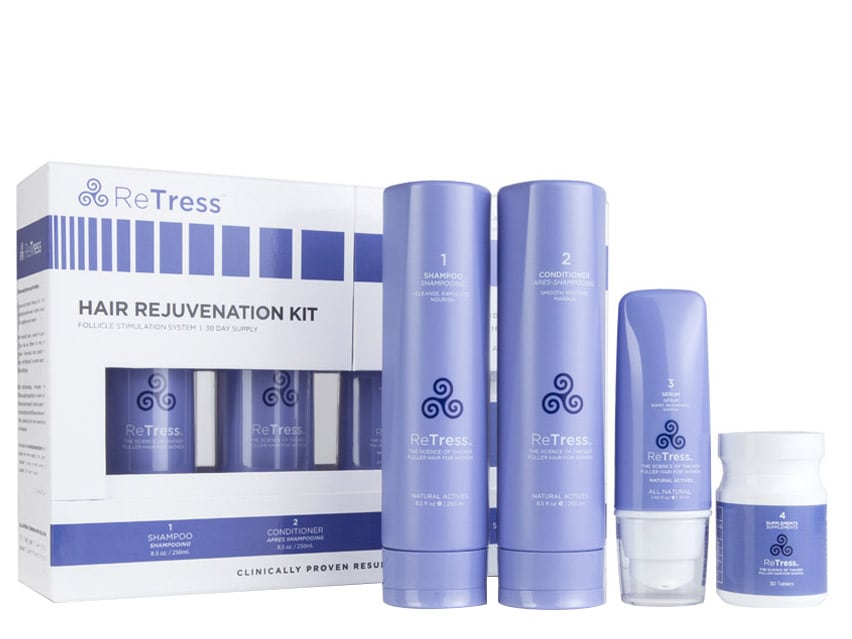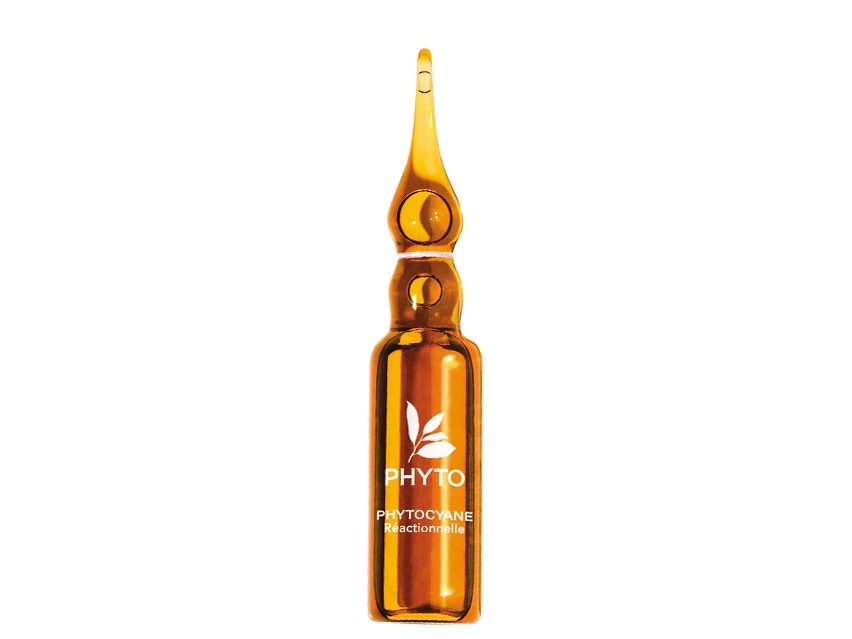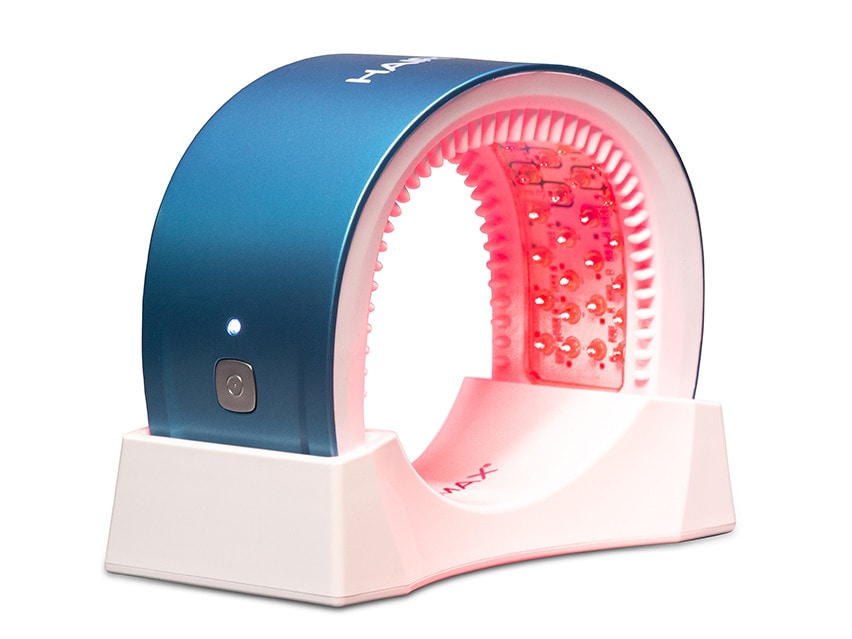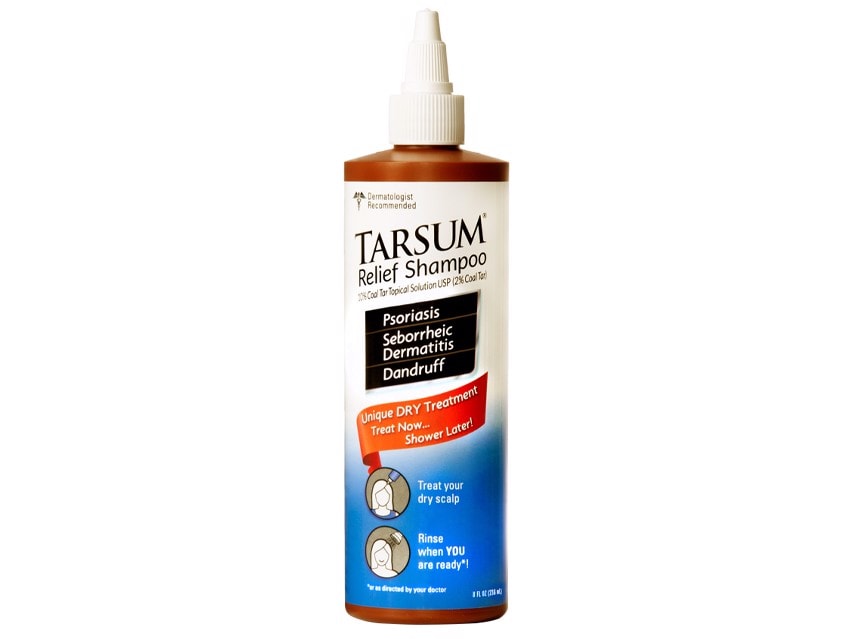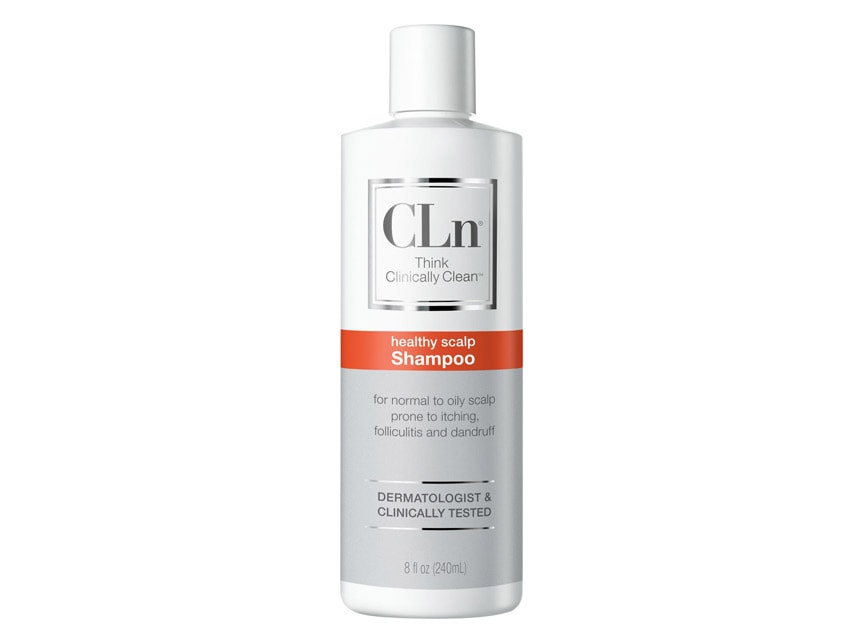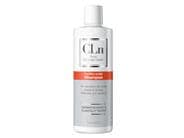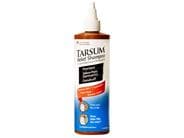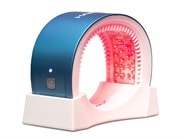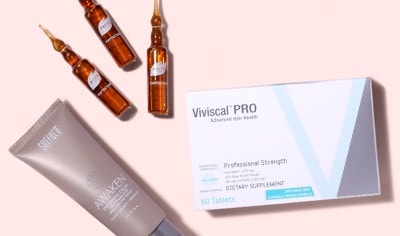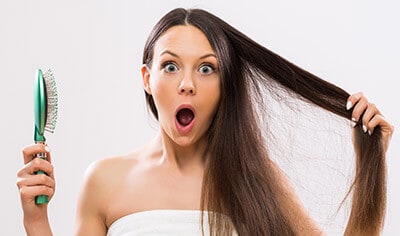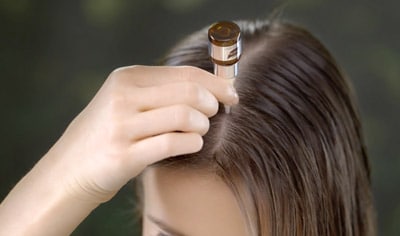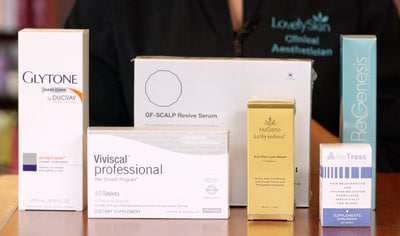
It’s considered normal to lose between 50 and 100 hairs a day, but when should you be concerned about the strands left behind in your brush or on your pillow? Hair loss, known clinically as alopecia, can appear suddenly or gradually and can range from mild thinning to complete baldness. It can affect not only the scalp but the eyebrows, eyelashes, beard and any other place on the body that has hair. Whether caused by hormones, certain hairstyles, stress or a medical condition, experiencing hair loss and thinning can be debilitating. With the help of Drs. Joel and Daniel Schlessinger, board-certified dermatologists as well as Mohs surgeons and cosmetic surgeons, we’re ready to take a deep dive into this topic and answer the following questions:
What causes hair thinning and hair loss?
LovelySkin CEO Dr. Joel Schlessinger says there are a number of reasons why hair loss seems to be more prevalent as of late. “We are seeing more hair loss than ever and are talking about hair loss more. This allows people to recognize it is treatable and treatments have improved over what we had in the past,” he says. “We are seeing a spike in hair loss due to hormonal treatments and the aftermath of them, and we have also seen COVID-19 play a role in hair loss. There’s also the possibility that hormone disruptors in our environment, whether that be from plastic in water bottles and other packaging are contributing to this increase in cases.”
That said, there are many established root causes for hair loss and hair thinning. Here are a few likely explanations why you may be seeing more loose hair than you’d like on your brush lately.
Why is my hair falling out? 6 common causes
Cause #1: Hormones
Hormone changes are one of the most common causes of hair thinning in women. Hair volume and density can change as the body goes through hormone-fluctuating events, such as pregnancy or menopause. During pregnancy, your body gets a boost of estrogen, which slows down the hair’s growth cycle and keeps your luscious locks intact. However, once you give birth, hormones normalize and some of the volume often falls out. It’s also suspected the hormone fluctuations in menopause may cause hair to thin.
If you suffer from an endocrine disorder like polycystic ovarian syndrome (PCOS), an excess of androgens (male hormones that are not-so-friendly to hair growth) can also cause hair to fall out. If you suspect you’re suffering from hair loss due to a hormonal imbalance, it’s important to check in with your dermatologist to evaluate and treat the underlying problem.
Cause #2: Allergens
It’s possible an allergic reaction to topical products you’re using on your hair or scalp could be contributing to hair thinning or hair loss. “Interestingly, allergens don’t always just cause itchy skin,” says Dr. Daniel Schlessinger. “For example, researchers have long wondered whether a form of scarring alopecia called frontal fibrosing alopecia—which causes you to lose hair from the frontal hairline and eyebrows—was due to allergic contact dermatitis. I was part of a research team that looked into this and found many of these patients may be allergic to cetrimonium bromide, which is often used in conditioners for its anti-frizz properties.”
Cause #3: Skin infections on the scalp
“Healthy hair begins at the scalp,” Dr. Joel Schlessinger says. “One cause of hair loss can be a skin infection or skin condition that could be negatively impacting the health of your scalp and, as a result, causing hair thinning or loss.” Skin infections on your scalp that can potentially damage hair follicles might be caused by fungus (commonly known as ringworm or bacteria (like folliculitis caused by staph. Chronic skin conditions such as eczema and psoriasis can also affect scalp health and can play a role in hair health as well.
Cause #4: Stress
While everyday stress doesn’t typically affect hair growth, extreme stress from a traumatic event, rapid weight loss or major surgery can affect your health in many ways, including hair thinning. With telogen effluvium, a scalp disorder that causes thinning or shedding hair, excessive stress pushes larger numbers of follicles into the resting phase and within a few months, hair can fall out from simple brushing or washing. As your stress levels return to a more normal state, hair thinning should start to slow.
Cause #5: Hair treatments and hairstyles
Tightly pulled hairstyle can sometimes lead to a type of hair loss called traction alopecia. Hair styles such as tight braids, buns or ponytails can pull on your hair and cause strands to fall out or break. Chemical treatments or bleaching can also weaken hair and contribute to breakage. You can help avoid excessive breakage and brittleness by spacing out these kinds of intensive treatments (or letting go and keeping hair au naturale) as well as saving your favorite up-do styles, like a tight topknot, for special occasions.
Cause #6: Other
There is a large “other” category that extends beyond the typical reasons why many people experience hair loss. Sometimes, it could simply be due to genetics or age. Other medical conditions such as auto-immune disorders, thyroid disorders or an inflammatory skin condition such as lichen planopilaris, could be to blame for hair loss or hair thinning. Iron deficiency anemia can also cause hair to fall out. Hair loss can also be a side effect of certain medications, such as blood thinners and lipid-lowering drugs for high cholesterol. A board-certified dermatologist can take a close look at your medical history and run the necessary tests to see if any of these medical conditions might be the root cause of your hair loss or hair thinning.
How to stop hair thinning and hair loss at home
“The first step to address hair loss or hair thinning is to visit a board-certified dermatologist to discuss your concerns,” Dr. Daniel Schlessinger says. “They can work with you to determine the source of hair thinning or hair loss and develop a treatment plan for you.” Your dermatologist might recommend lifestyle changes or a prescription medication or over-the-counter treatment to try at home.
Throughout his years treating patients for hair loss and hair thinning, Dr. Joel Schlessinger has come to trust and recommend a number of solutions, including oral supplements, laser devices and scalp treatments. Here are a few of his trusted recommendations that you can consider to help stop hair thinning and loss.
Viviscal Professional Supplements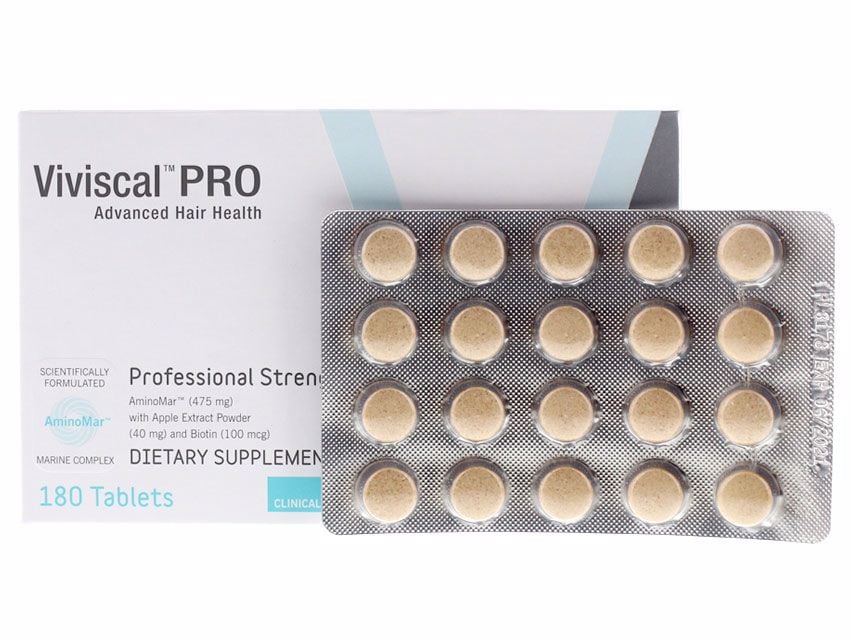
This oral supplement for hair growth contains vitamin C, biotin, apple extract to strengthen weak and thinning hair as well as an exclusive marine complex called AminoMar that encourages new hair growth. “Viviscal supplements work by providing nutrients that make their way through your bloodstream and boost hair growth at the source by nourishing your hair follicles, while also improving the overall skin and nails. It is derived from shark cartilage, so if you have a seafood allergy, this may not be for you,” Dr. Joel Schlessinger says.
“It takes a minimum of three to six months of consistent use to start to see results, and I often recommend this to patients who are looking for an alternative to prescription hair-loss treatments,” Dr. Joel Schlessinger says. Viviscal also makes a Thickening Shampoo that promotes healthy hair growth with a proprietary complex called Ana:Tel that’s derived from pea sprouts and grape seeds and a Thickening Elixir that improves the appearance of hair with biotin, keratin, marine collagen and seaweed extract.
ReTress Hair Rejuvenation Kit
ReTress is a product line created by board-certified dermatologist Dr. Candace Spann to help women reduce hair shedding and restore fuller-looking hair. This kit contains four products meant to be used together as a system: a shampoo, conditioner, oral supplement and scalp serum. Key ingredients include a tri-peptide complex to nourish hair follicles and apigenin to improve hair anchoring. In a sixteen-week clinical trial, 95% of women saw moderate or significant improvement in their hair density after using these four products.
PHYTO Phytocyane Revitalizing Treatment for Women Reactional Hair Thinning
Innovative hair care brand PHYTO specializes in botanically based solutions for scalp and hair issues, and this scalp serum was formulated to address sudden hair loss that has occurred over less than three months as a result of stress or pregnancy. It contains ginkgo biloba leaf extract to help improve microcirculation in the scalp for healthy hair growth and silk proteins and glycerin to help existing hair look fuller and shinier. In a clinical trial, [94% of users](https://us.phyto.com/products/phytocyane-revitalizing-treatment-for-women?gad source=1&gclid=CjwKCAjwgdayBhBQEiwAXhMxtiGCDQ5nvCFCmbfNGkbjTqsZGqv9Cbh8-H6Ge30WkWeivJNmJji6BoCCEIQAvD_BwE/ _blank) reported that their hair looked more voluminous after one month of use.
HairMax LaserBand 82 ComfortFlex Hair Growth Device
This headband-shaped laser hair growth device was created to treat hereditary thinning hair or pattern baldness. It features medical-grade lasers that specifically target your hair follicles to stimulate hair growth. During each 90-second daily treatment, the comb-like teeth on the device help separate your hair strands so the low-level laser light energy can reach your scalp for the most effective penetration.
Rene Furterer Progressive Thinning Hair Ritual
This five-piece kit from plant-based product line Rene Furterer provides a comprehensive approach to improving hair thinning caused by hereditary or hormonal factors with a thickening shampoo and texturizing conditioner to help improve the appearance of existing hair as well as three targeted treatments to help improve scalp health.
The first is Head Spa Complexe, a pre-shampoo treatment to help purify your scalp and improve microcirculation for healthy hair growth. Next, you can use the Triphasic Progressive Concentrated Serum, a concentrated leave-in serum, to help stimulate hair growth with biotrinine. Lastly, Vitalfan Progressive Dietary Supplements help support healthy hair growth with niacin and orange extract.
Tarsum Relief Shampoo
If you have psoriasis on your scalp, it can cause scaly patches called plaques that can interfere with hair growth. “Scalp psoriasis can be itchy, and scratching can make it even worse,” Dr. Joel Schlessinger says. “I recommend this medicated shampoo to help relieve itchiness and irritation, allowing your scalp to heal.” Key ingredients in this shampoo formula include coal tar and salicylic acid to help improve the psoriasis plaques that can be a root cause of hair thinning or hair loss.
CLn Shampoo
If a scalp infection such as folliculitis is to blame for your thinning hair, a medicated shampoo such as this one by CLn can help. Salicylic acid helps exfoliate the scalp build-up that can contribute to folliculitis, while sodium hypochlorite helps eliminate the bacteria that causes the infection. “Folliculitis can be an issue on the face and the scalp, and this shampoo can be used as a beard wash as well,” Dr. Daniel Schlessinger says.
Surface Awaken Box Set
Hair and scalp care brand Surface created the Awaken line to help treat thinning hair and hair loss that occurs as a result of stress, hormone changes or skin conditions such as psoriasis. This four-piece kit features a blend of ingredients that help support optimum scalp health and healthy hair growth, including lysine, saw palmetto, proteins and amino acids. These products are also safe to use on color-treated hair thanks to the inclusion of Surface’s Color Vita Complex, a proprietary blend of ceramides and antioxidants.
Are you looking for more options to help improve the appearance of thinning hair? You can browse our full range of hair loss products available on LovelySkin.
Shop this blog

About the Author
Ashley is a Digital Content Specialist at LovelySkin with a passion for non-fiction and poetry writing. In her spare time, she enjoys trying new lip products, spoiling her pets, going to concerts, and reading.
Other Posts by AshleyProduct spotlight: SkinCeuticals C E Fer...
All about La Roche-Posay's Thermal Sprin...
Follow us on social
Follow us on social networks and be one of the first to learn about sales, giveaways, and free samples

